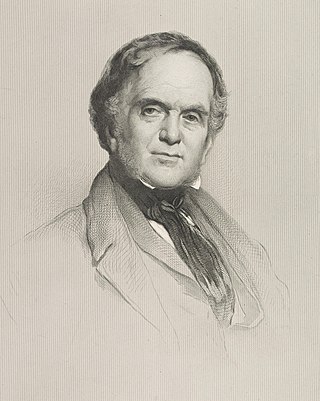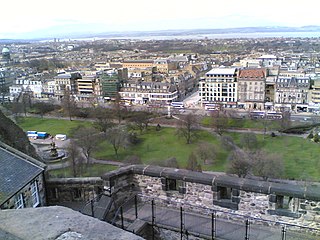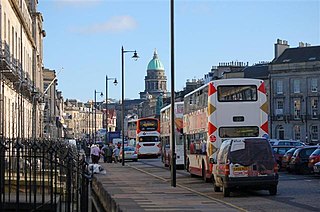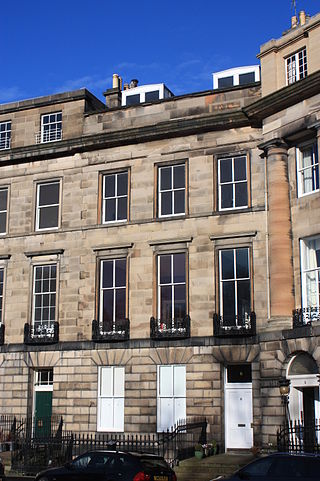
William Henry PlayfairFRSE was a prominent Scottish architect in the 19th century who designed the Eastern, or Third, New Town and many of Edinburgh's neoclassical landmarks.

Thomas Hamilton was a Scottish architect, based in Edinburgh where he designed many of that city's prominent buildings. Born in Glasgow, his works include: the Burns Monument in Alloway; the Royal High School on the south side of Calton Hill ; the Royal College of Physicians of Edinburgh; the George IV Bridge, which spans the Cowgate; the Dean Orphan Hospital, now the Dean Gallery; the New North Road Free Church, now the Bedlam Theatre; Cumstoun, a private house in Dumfries and Galloway; and the Scottish Political Martyrs' Monument in Old Calton Cemetery, Edinburgh.

James Gillespie Graham was a Scottish architect, prominent in the early 19th century.

The New Town is a central area of Edinburgh, the capital of Scotland. It was built in stages between 1767 and around 1850, and retains much of its original neo-classical and Georgian period architecture. Its best known street is Princes Street, facing Edinburgh Castle and the Old Town across the geological depression of the former Nor Loch. Together with the West End, the New Town was designated a UNESCO World Heritage Site alongside the Old Town in 1995. The area is also famed for the New Town Gardens, a heritage designation since March 2001.

Archibald Simpson was a Scottish architect, who along with his rival John Smith, is regarded as having fashioned the character of Aberdeen as "The Granite City".

The Royal Exchange Square is a public square in Glasgow, Scotland. The square lies between Buchanan Street and Queen Street, opening out Queen Street and Ingram Street to the south of George Square. It is also easily accessible from Buchanan Street on the west side of the square, through two prominent archways at Royal Bank Place. The square is a landmark due to its distinguished architecture which attracts many visitors. It is one of six squares in the city centre.

Robert Reid was the King's architect and surveyor for Scotland from 1827 to 1839. He is responsible for a number of public works particularly the façade of Parliament Square in Edinburgh, which houses the Court of Session. Stylistically he was heavily influenced by Robert Adam, but Reid's style is more austere. The style is now seen as the main character of the northern Edinburgh New Town and without Reid Edinburgh would today be a very different city.

Archibald Elliot was a Scottish architect based in Edinburgh. He had a very distinctive style, typified by square plans, concealed roofs, crenellated walls and square corner towers. All may be said to derive from the earlier local example of Melville Castle by James Playfair. Many of his works have been demolished.

The West End is an affluent district of Edinburgh, Scotland, which along with the rest of the New Town and Old Town forms central Edinburgh, and Edinburgh's UNESCO World Heritage Site. The area boasts several of the city's hotels, restaurants, independent shops, offices and arts venues, including the Edinburgh Filmhouse, Edinburgh International Conference Centre and the Caledonian Hotel. The area also hosts art festivals and crafts fairs.

The Dean Bridge spans the Water of Leith in the city of Edinburgh on the A90 road to Queensferry on the Firth of Forth. It carries the roadway, 447 feet (136 m) long and 39 feet (12 m) broad, on four arches rising 106 feet (32 m) above the river. The bridge was one of the last major works before retirement of the bridge designer, civil engineer Thomas Telford, and was completed in 1831 when he was seventy-three years old.
Alexander Handyside Ritchie was a Scottish sculptor born in Musselburgh in 1804, the son of James Ritchie, a local brickmaker and ornamental plasterer, and his wife Euphemia. The father in turn was the son of a fisherman and amateur sculptor.

John Chesser (1819-1892) was a nineteenth-century Scottish architect largely based in Edinburgh. He was described as "the prime exponent of terrace design at the time". A very high number of his works are now category A listed buildings, evidencing the quality of his work, particularly in the West End of Edinburgh.
Robert Reid Raeburn was a Scottish architect in the mid-19th century operating primarily in and around Edinburgh.

Richard and Robert Dickson were brothers, acting as architects in Scotland in the early and mid-19th century. Whilst most of their work is typified by remote country houses they are best known for their magnificent spire on the Tron Kirk in the heart of Edinburgh on the Royal Mile.

John Learmonth of Dean, DL FRSE was Lord Provost of Edinburgh from 1831 to 1833. He was co-funder of the Dean Bridge project in western Edinburgh and gives his name to many of the streets in Comely Bank, the district to the north-west of the bridge. He was a Tory politician and also chairman of the Edinburgh and Glasgow Railway Company.
James Leslie FRSE was a Scottish civil engineer specialising in docks, harbours bridges and reservoirs, largely on the east coast of Scotland. He was also an amateur meteorologist.

The Dean Gardens are private communal gardens near the Stockbridge suburb of the New Town area of Edinburgh, EH4. The gardens lie over a 2.9 hectares sized site on the steep north bank of the Dean Valley through which runs the Water of Leith. A public view of the gardens can be seen from the Dean Bridge, under which the gardens lie. The gardens have been listed on the Inventory of Gardens and Designed Landscapes as part of the New Town Gardens heritage designation since March 2001.

William Allan of Glen JP (1788–1868) was a 19th-century Scottish merchant who served as Lord Provost of Edinburgh from 1829 to 1831.

Sir James Steel, 1st Baronet (1830–1904) was a Scottish builder and businessman who served as Lord Provost of Edinburgh from 1900 to 1903.
The New Town Gardens are a collection of around 30 mostly private gardens and parks within the Edinburgh New Town Conservation Area spread across the New Town and the West End, listed as a heritage designation since March 2001. The gardens comprise a series of 18th and 19th century town gardens, squares and walks, established contemporaneously with the New Town of Edinburgh between 1767 and around 1850.



















